Kin Exam Review Part 2
1/46
There's no tags or description
Looks like no tags are added yet.
Name | Mastery | Learn | Test | Matching | Spaced |
|---|
No study sessions yet.
47 Terms
What are the 9 muscles of the shoulder joints?
MNEMONIC TO REMEMBER: People Can Swim Laps To Develop Incredible Strength, Too
Pectoralis Major (anterior), coracobrachialis (anterior), subscapularis (anterior), latissimus dorsi (posterior), teres major (posterior), deltoid (superior), infraspinatus (posterior), supraspinatus (posterior), teres minor

List the Origin, Insertion, Actions, and Antagonist of the Pectoralis Major (anterior) of the SHOULDER JOINT
Origin: medial half of clavicle, ribs 1-6, sternum
Insertion: intertubercular groove of humerus
Action(s):
Upper:
internal rotation,
diagonal ADduction
Horizontal ADduction
Flexion
ABduction (assist above 90 degrees)
ADduction (assist below 90 degrees)
Lower:
internal rotation
horizontal ADduction
ADduction and EXtension from flexed to anatomical position
Antagonist: latissimus muscle
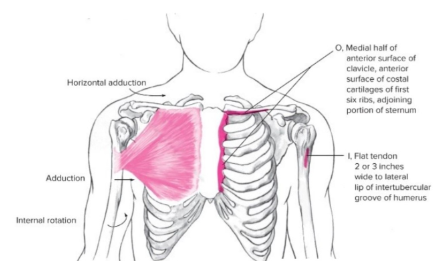
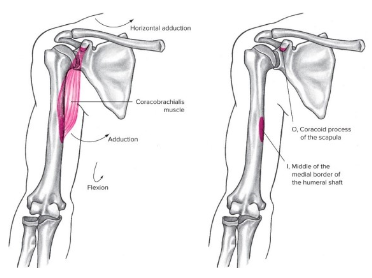
List the Origin, Insertion, Actions, and Antagonist of the Coracobrachialis (Anterior) of the SHOULDER JOINT
Origin: coracoid process
Insertion: medial border of humerus shaft
Action(s):
flexion,
ADduction
horizontal ADduction
Antagonist: latissimus muscle, infraspinatus*

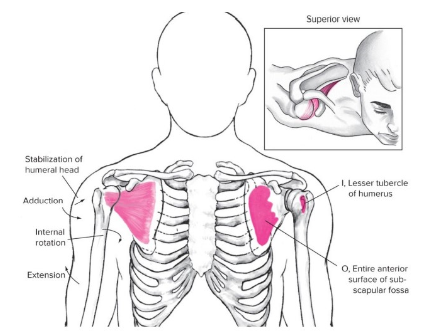
List the Origin, Insertion, Actions, and Antagonist of the Subscapularis (Anterior) - part of rotator cuff of the SHOULDER JOINT
Origin: subscapular fossa
Insertion: lesser tubercle of humerus
Action(s): EX INR AB
EXtension
INternal rotation
ABduction
Antagonist: infraspinatus and teres minor*
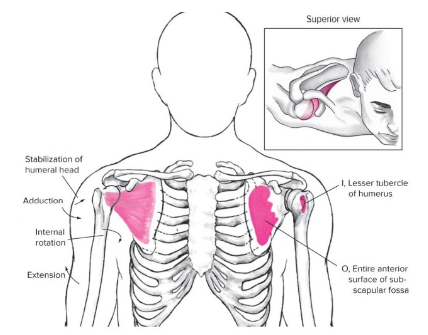
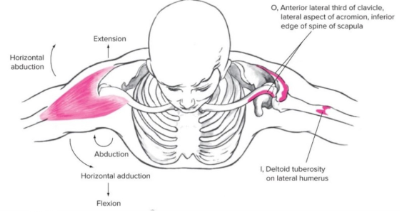
List the Origin, Insertion, Actions, and Antagonist of the Deltoid (Superior) of the SHOULDER JOINT
Origin: clavicle, acromion process, scapular spine
Insertion: deltoid tuberosity on lateral humerus
Action(s):
Anterior:
ABduction
horizontal ADduction
Flexion
internal rotation
Middle:
ABduction
horizontal ABduction
Posterior:
ABduction
horizontal ABduction
Extension
external rotation
Antagonist: (LPMajor)
Latissimus dorsi
Pectoralis MAJOR

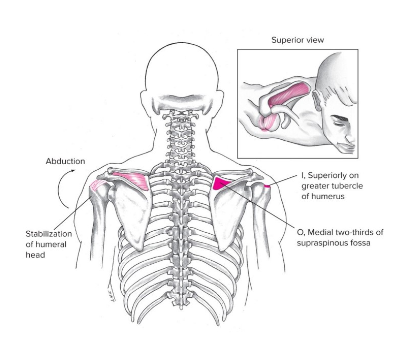
List the Origin, Insertion, Actions, and Antagonist of the Supraspinatus (Posterior) - Part of rotator cuff of the SHOULDER JOINT
Origin: supraspinous fossa
Insertion: greater tubercle of humerus
Action(s):
ABduction
Antagonist:STMajorLC
Subscapularis,
Teres Major,
Latissimus dorsi,
Coracobrachiallis
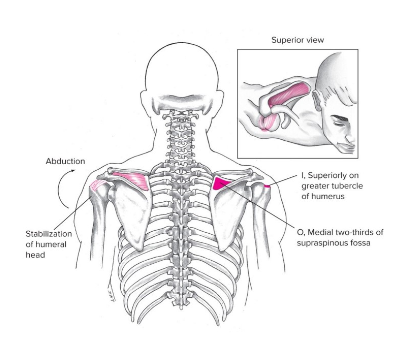
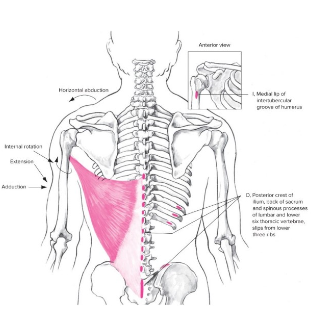
List the Origin, Insertion, Actions, and Antagonist of the Latissimus Dorsi (Posterior) of the SHOULDER JOINT
Origin: POSTERIOR crest of ILIUM, SACRUM,, spinous PROCESS of LOWER vertebrae lower 3 RIBS
Insertion: intertubercular groove of humerus
Action(s):
ADduction
Horizontal ABduction
EXension
INternal rotation
EXternal rotation
Antagonist: BCDISspinatus
Biceps brachii
Coracobrachialis
Deltoid
Infraspinatus
Supraspinatus
pectoralis major

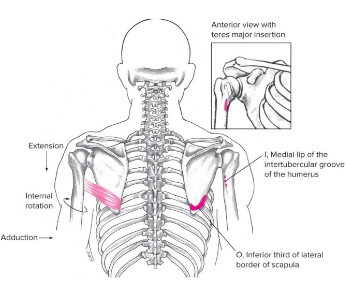
List the Origin, Insertion, Actions, and Antagonist of the Teres Major (Posterior) of the SHOULDER JOINT
Origin: INFERIOR scapula
Insertion: intertubercular groove of humerus
Action(s): EX INR AD
EXtension
INternal rotation
ADduction
Antagonist: DTPminor
Deltoid,
Trapezius,
Pectoralis MINOR*

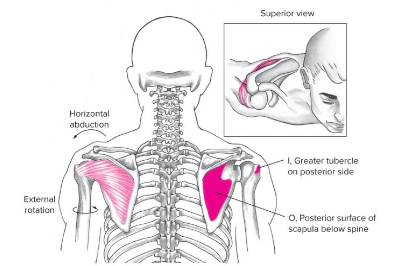
List the Origin, Insertion, Actions, and Antagonist of the Infraspinatus (Posterior) - Part of the rotator cuff of the SHOULDER JOINT
Origin: POSTERIOR scapula
Insertion: greater tubercle of humerus
Action(s):
Extension,
EXternal rotation ,
horizontal ABduction
Antagonist:
Serratus anterior,
Pectoralis major
Pectoralis MINOR,

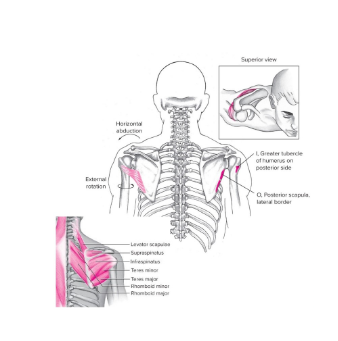
List the Origin, Insertion, Actions, and Antagonist of the Teres Minor (Posterior) - Part of the rotator cuff of the SHOULDER JOINT
Origin: POSTERIOR scapula (lateral border)
Insertion: greater tubercle of humerus (posterior)
Action(s):
extension,
external rotation,
horizontal ABduction
Antagonist: STLsD
serratus anterior,
trapezius,
deltoid,
levator scapulae*
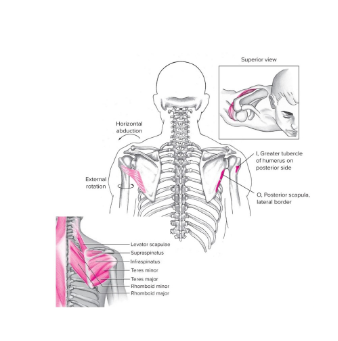
Name the 4 muscles that make up the rotator cuff
Subscapularis, supraspinatus, infraspinatus, teres minor
What are the 8 muscles of the elbow and radioulnar joints?
MNEMONIC TO REMEMBER: Beautiful Birds Build Pretty Pink Tricycles And Scooters
Biceps brachii, brachialis, brachioradialis, pronator teres, pronator quadratus, triceps brachii, anconeus, and supinator muscle

List the Origin, Insertion, Actions, and Antagonist of the Biceps Brachii (Elbow flexors - generally anterior) of the ELBOW AND RADIOULNAR JOINTS
Origin:
long head: SUPRAglenoid tubercle
short head: coraCOID process of SCAPULA
Insertion: radial tuberosity
Action(s):
Supination of the forearm
Flexion of the elbow
Horizontal adduction of the shoulder joint
Weak flexion of the shoulder joint
Weak abduction of the shoulder joint
Antagonist: triceps brachii
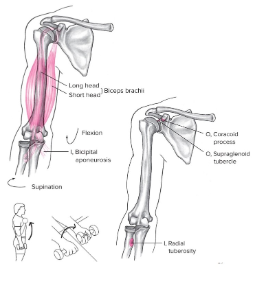
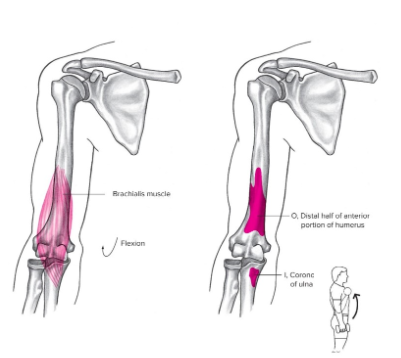
List the Origin, Insertion, Actions, and Antagonist of the Brachialis (Elbow flexors - generally anterior) of the ELBOW AND RADIOULNAR JOINTS
Origin: DISTAL ANTERIOR shaft of the HUMERUS
Insertion: coroNOID process of the ULNA
Action(s): ELBOW FLEXION
Antagonist: tricep brachii*
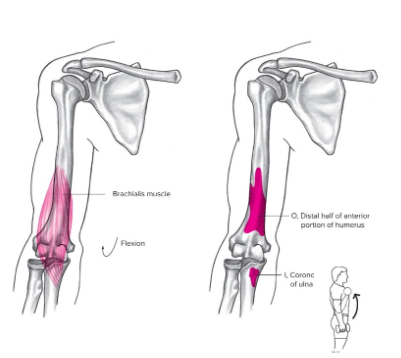
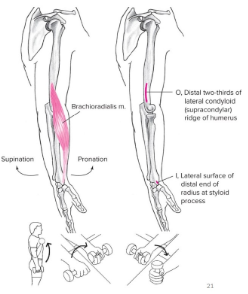
List the Origin, Insertion, Actions, and Antagonist of the Brachioradialis (Elbow flexors - generally anterior) of the ELBOW AND RADIOULNAR JOINTS
Origin: DISTAL⅔ of the LATERAL SUPRACONDYLAR RIDGE of the HUMERUS
Insertion: LATERAL SURFACE DISTAL RADIUS @ STYLOID PROCESS
Action(s):
ELBOW FLEXION
Pronation from supination to neutral
Supination from pronation to neutral
Antagonist: triceps brachii and ACRONEUS**
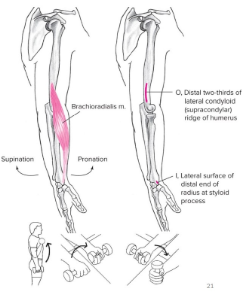
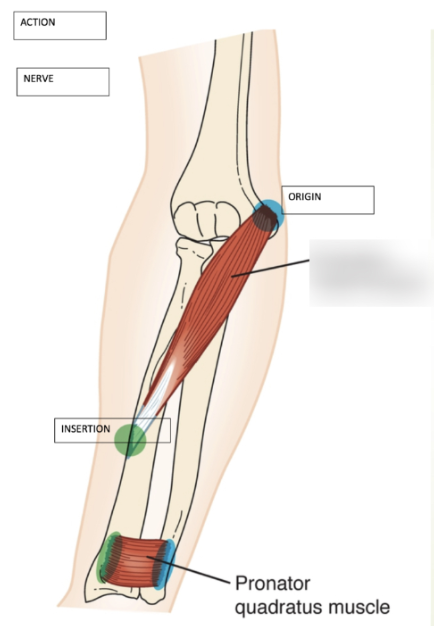
List the Origin, Insertion, Actions, and Antagonist of the Pronator Teres (Elbow flexors - generally anterior) of the ELBOW AND RADIOULNAR JOINTS
Origin: DISTAL MEDIAL SUPRACONDYLAR RIDGE HUMERUS and MEDIAL SIDE of the PROXIMAL ulna
Insertion: LATERAL (MIDDLE⅓) RADIUS
Action(s):
PRONATION of the forearm,
WEAK ELBOW FLEXION
Antagonist: supinator muscles
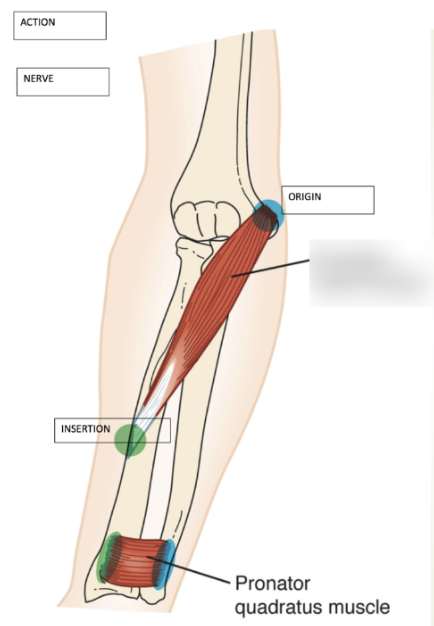

What is number 1 in the picture
Origin
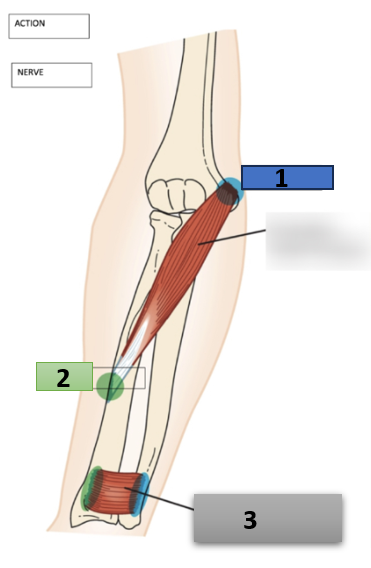
What is number 2 in the picture
Insertion

What is number 3 in the picture
Pronator quadratus muscle
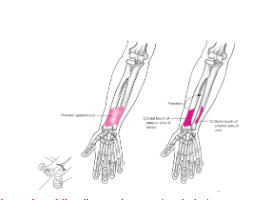
List the Origin, Insertion, Actions, and Antagonist of the Pronator Quadratus (Radioulnar pronators - generally anterior) of the ELBOW AND RADIOULNAR JOINTS
Origin: DISTAL ¼ of the ANTERIOR side of the ULNA
Insertion: DISTAL ¼ of the ANTERIOR side of the RADIUS
Action(s): pronation of the forearm
Antagonist: Supinator*
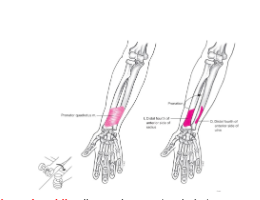
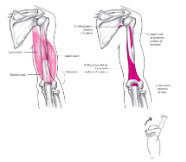
List the Origin, Insertion, Actions, and Antagonist of the Triceps Brachii (Elbow extensors - Posterior) of the ELBOW AND RADIOULNAR JOINTS
Origin:
LONG HEAD: INFRAglenoid tubercle of scapula
LATERAL head: POSTERIOR surface of HUMERUS, SUPERIOR TO RADIAL GROOVE
MEDIAL head: POSTERIOR surface of HUMERUS, INFERIOR TO RADIAL GROOVE
Insertion: OLECRANON process of ULNA
Action(s):
EXtension,
ADduction
Antagonist: biceps brachii


List the Origin, Insertion, Actions, and Antagonist of the Anconeus (Elbow extensors - Posterior) of the ELBOW AND RADIOULNAR JOINTS
Origin: POSTERIOR LATERAL CONDYLE (HUMERUS)
Insertion: POSTERIOR LATERAL OLECRANON PROCESSES and PROXIMAL ¼ of the ULNA
Action(s):
ELBOW EXTENSION
Antagonist:
BICEPS BRACHII
brachioRADIALIS
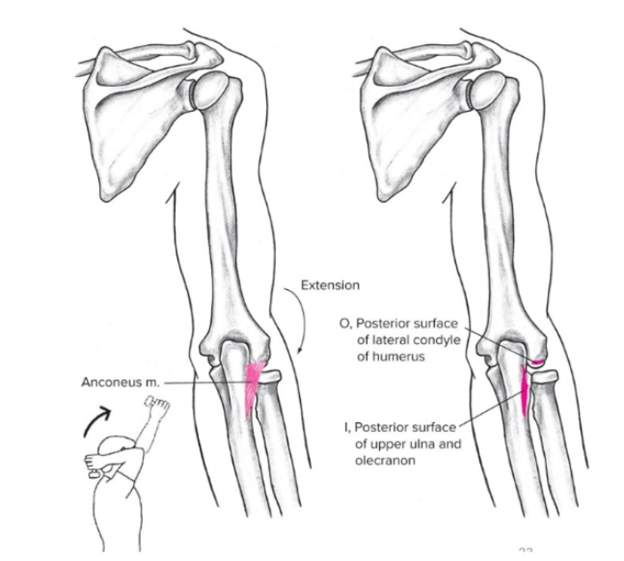
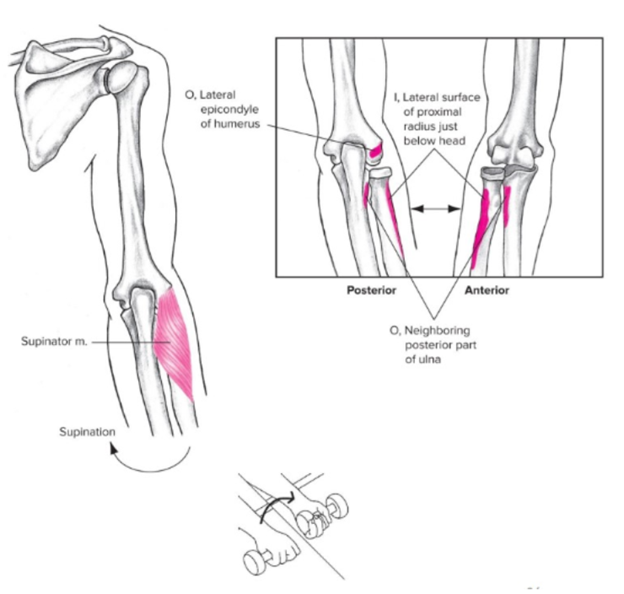
List the Origin, Insertion, Actions, and Antagonist of the Supinator Muscle (Radioulnar Supinators - Posterior) of the ELBOW AND RADIOULNAR JOINTS
Origin: LATERAL EPICONDYLE of the HUMERUS and NEIGHBORING POSTERIOR ULNA
Insertion: LATERAL surface of the PROXIMAL RADIUS (BELOW HEAD)
Action(s): supination of the forearm
Antagonist: pronator quadratus
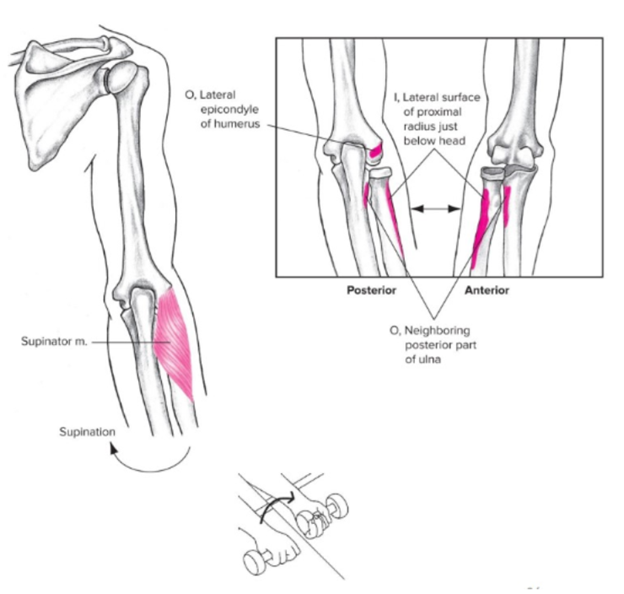
Draw a line from the glenohumeral movement to the corresponding shoulder girdle movement(s)
LOOK AT FRIEND’S DOC. NOT INCLUDED IN THIS FLASHCARD.

Fill in the blank, according to the picture above the statement:
The _____, ______, ______ muscles cause _____ to occur in the _____ plane about the ______axis.
RESTATE THE ENTIRE SENTENCE WITH THE ANSWER.
The biceps, brachioradialis, brachialis muscles cause flexion to occur in the sagittal plane about the frontal axis.
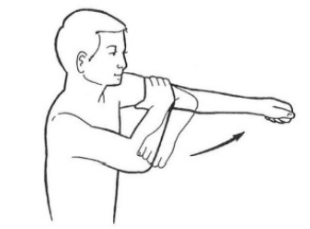
Fill in the blank, according to the picture above the statement:
Extension of the elbow:
The ______, _____ muscles cause _______ to occur in the _____ plane about the _____ axis.
RESTATE THE ENTIRE SENTENCE WITH THE ANSWER.
The triceps brachii, anconeus muscles cause extension to occur in the sagittal plane about the frontal axis.
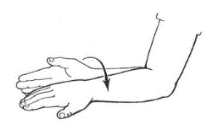
Fill in the blank, according to the picture above the statement:
Extension of the elbow:
The ______, _______, ________ muscles cause ______ to occur in the ________ plane about the ________ axis.
RESTATE THE ENTIRE SENTENCE WITH THE ANSWER.
The pronator teres, pronator quadratus, brachioradialis muscles cause pronation to occur in the transverse plane about the vertical axis.
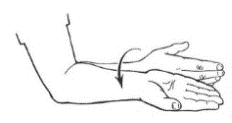
Fill in the blank, according to the picture above the statement:
Extension of the elbow:
The ______, _______, _______ muscles cause ________ to occur in the ________ plane about the vertical axis.
RESTATE THE ENTIRE SENTENCE WITH THE ANSWER.
The supinator, brachioradialis, biceps muscles cause supination to occur in the transverse plane about the vertical axis.
What are the 8 key bony landmarks of the scapula in the skeleton of the upper thorax and upper extremity?
MNEMONIC TO HELP REMEMBER: Superior Individuals Seek Super Great Companions In Awe
supraspinous fossa, infraspinous fossa, subscapular fossa, spine of the scapula, glenoid cavity, coracoid process, inferior angle, and acromion process.
These are the bony landmarks of what?
Supraspinous fossa
Infraspinous fossa
Subscapular fossa
Spine of the scapula
Glenoid cavity
Coracoid process
Inferior angle
Acromion process
scapula in the skeleton of the upper thorax and upper extremity
What bones are involved in the formation of the elbow joint?
The bones involved in the formation of the elbow joint are the humerus, radius, and ulna
Which bones articulate in the radioulnar joints?
The radioulnar joints articulate between the radius and ulna.
How are the elbow joint and radioulnar joint intimately associated?
The elbow joint and radioulnar joint are intimately associated because both bones of the radioulnar joint, the radius and ulna, share an articulation with the humerus to form the elbow joint.
During the pushing up (lifting) phase of the push-up, what is the force providing movement: Muscles or Gravity?
Muscles
What are the 3 muscles are responsible for the lifting phase of a push-up?
pectoral muscles, triceps, and anterior deltoid
What type of muscle contraction is occurring during the pushing up phase of a push-up? (Isometric, Concentric, Eccentric)
Concentric contraction
Two muscles extend the elbow during a push-up. What are these muscles?
Triceps brachii and anconeus (Push ups demand strenuous contraction of these muscles)
What movement is occurring at the shoulder girdle during a push-up, and which muscles contribute to this movement?
Movement: Protraction at the scapula, Abduction at the shoulder girdle
Muscles: Serratus anterior (stabilizes), Pectoralis minor
What movement occurs at the shoulder joint during a push-up, and which muscles contribute to this movement?
Movement: Horizontal adduction, Flexion at the shoulder joint
Muscles: Deltoids (anterior), Pectoralis major
What movement occurs at the elbow during a push-up, and which muscles contribute to this movement?
Movement: Extension (concentric contraction)
Muscles: Triceps
What movement occurs at the elbow during the lowering phase of a push-up?
Elbow flexion
During the lowering phase of the pull-up, what is the force providing movement? Muscles or Gravity?
Gravity
What type of contraction is occurring in muscles during the lowering phase of the pull-up?
Eccentric (in eccentric movement, resistance always wins)
What muscles are concentrically contracting during the lowering phase of the pull-up?
Friends answer:
During the lowering phase of the pull up it should be ECCENTRIC movements.
Google’s answer:
None (Concentric contractions occur during the lifting or upward phase of the pull-up)
What movement should occur at the shoulder during the lowering phase of the pull-up? What muscles are contributing to this movement?
Movement: Upward rotation
Muscles contributing: Lower pectoralis major, upper lat dorsi, and teres major
What movement is occurring at the shoulder joint during the lowering phase of the pull-up? What muscles are contributing to this movement?
Movement: ABduction
Muscle contributing: Rear Delts
What movement is occurring at the elbow during the lowering phase of the pull-up? What muscles are contributing to this movement?
Movement: Elbow extension
Muscle contributing: Eccentric triceps